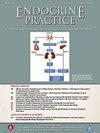Influence of Radioiodine Therapy on Oral Health and Salivary Production in Patients With Differentiated Thyroid Carcinoma
IF 3.7
3区 医学
Q2 ENDOCRINOLOGY & METABOLISM
引用次数: 0
Abstract
Objective
To evaluate the characteristics related to oral health and salivary production in patients with differentiated thyroid carcinoma (DTC) after radioiodine therapy (RIT).
Methods
Cross-sectional study, which included patients with DTC after ablative and/or adjuvant RIT. Patients underwent assessment of oral health conditions, subjective assessment of xerostomia, and measurement of salivary flow. Salivary glands were assessed by cervical ultrasound at the time of clinical evaluation.
Results
Sixty-seven DTC patients were included. Oral health was found very good or good in 60% of patients, 84% had no dental plaque or a slight amount, and 53% had normal-looking gums. There was a negative correlation between the salivary flow with activity of RIT ablative, number of RITs received, and total activity of radioiodine administered until oral assessment. Reduction in parotid gland volume on ultrasound was associated with greater number of times receiving RIT, longer time between RIT and patient assessment, greater 131I activity administered.
Conclusion
Good or very good oral health was observed in 60% of patients with DTC after RIT, 15% reported hyposalivation, and 13%, frequent xerostomia. Higher number and higher total activity of radioiodine administered, as well as reduction in the volume and heterogeneous texture of parotid gland on ultrasound were predictive factors of lower salivary flow.
放射性碘治疗对分化型甲状腺癌患者口腔健康及唾液分泌的影响。
目的:探讨分化型甲状腺癌(DTC)患者放射碘治疗(RIT)后口腔健康和唾液分泌的相关特征。方法:横断面研究,纳入消融和/或辅助RIT后DTC患者。患者接受口腔健康状况评估、口干主观评估和唾液流量测量。临床评价时采用宫颈超声检查唾液腺。结果:纳入67例DTC患者。60%的患者口腔健康状况非常好或良好,84%的患者没有牙菌斑或有少量牙菌斑,53%的患者牙龈外观正常。唾液流量与RIT消融活性、接受的RIT数量和放射性碘总活性呈负相关,直至口服评估。超声显示腮腺体积减小与接受RIT的次数越多,RIT与患者评估之间的时间越长,给予的131I活性越高有关。结论:RIT术后60%的DTC患者口腔健康状况良好或非常好,15%出现唾液分泌不足,13%出现口干。高剂量和高总活性的放射性碘,以及超声显示腮腺体积和质地不均的缩小是低唾液流量的预测因素。
本文章由计算机程序翻译,如有差异,请以英文原文为准。
求助全文
约1分钟内获得全文
求助全文
来源期刊

Endocrine Practice
ENDOCRINOLOGY & METABOLISM-
CiteScore
7.60
自引率
2.40%
发文量
546
审稿时长
41 days
期刊介绍:
Endocrine Practice (ISSN: 1530-891X), a peer-reviewed journal published twelve times a year, is the official journal of the American Association of Clinical Endocrinologists (AACE). The primary mission of Endocrine Practice is to enhance the health care of patients with endocrine diseases through continuing education of practicing endocrinologists.
 求助内容:
求助内容: 应助结果提醒方式:
应助结果提醒方式:


